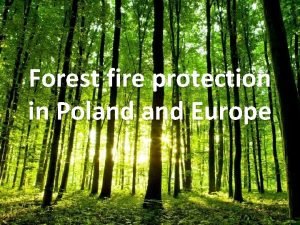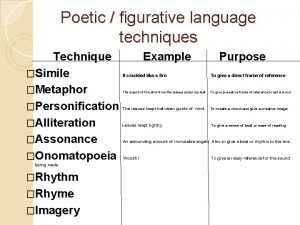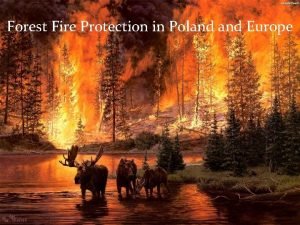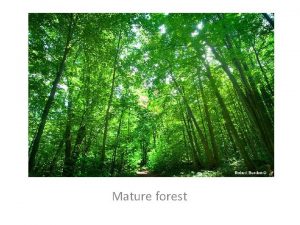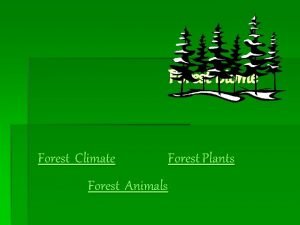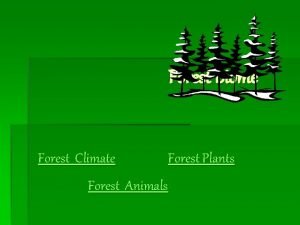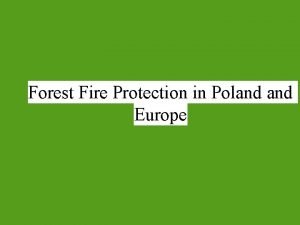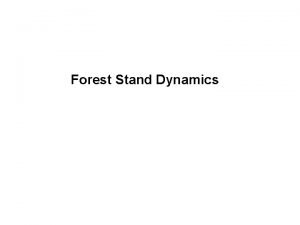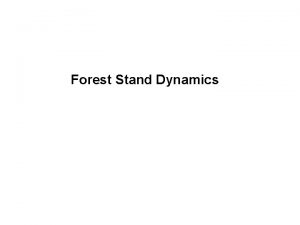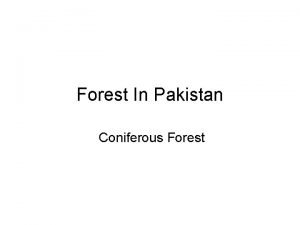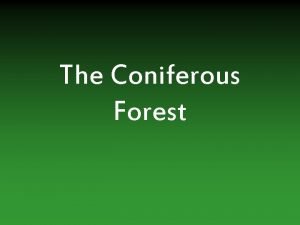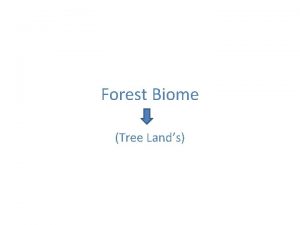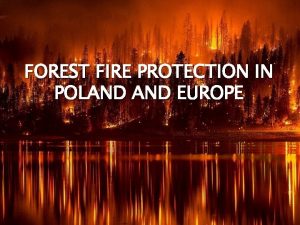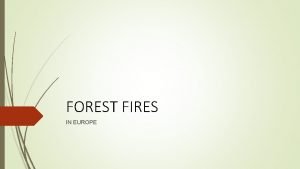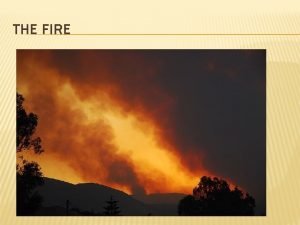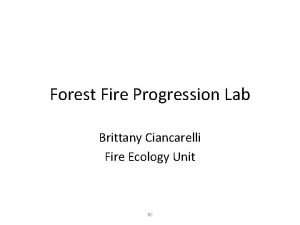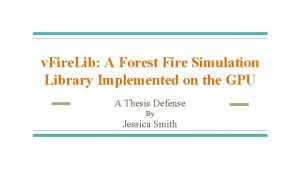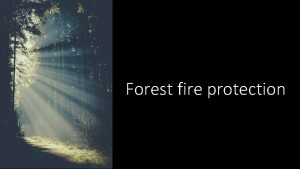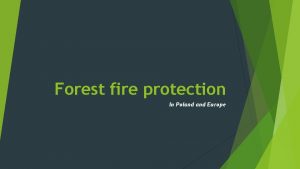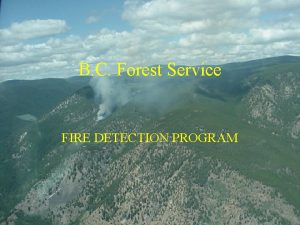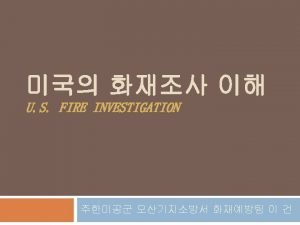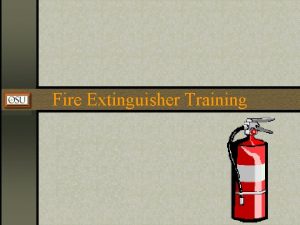FIRE THE FOREST 1 FOREST FIRE PART OF











































- Slides: 43

FIRE & THE FOREST 1

FOREST FIRE – PART OF ECOSYSTEM Fires in forest are not unnatural. It has been a natural part of the ecosystem since origin of forest on this planet. Most of the fires are very useful for regeneration. Fire effects on all forests are not equal. While same fire, beneficial for one ecosystem, may be dreadful for the other, depending upon the climatic conditions and type of vegetation. Fire severity affects the survival and establishment of many shrub species, organic matter consumption, soil heating and the biological response of soil flora and fauna. Soil heating due to fire , changes its chemical, physical and microbial properties. 2

3

CAUSES OF WILDFIRES Wildfires are different from other fires in their size, speed, and unpredictability. Wildfires can occur due to natural or man-made elements. The four most common natural elements that can cause a wildfire are lightning an eruption from a volcano sparks from a rock fall spontaneous combustion 4

ANTHROPOGENIC CAUSES te ra e b eli D • Shifting Cultivation • To flush growth of tress • To have good growth of grass and fodder • To settle score with forest department. Or personal rivalry • To clear path by villagers • To encroach upon the forest land • For concealing illicit felling • Tribal traditions/ custom e d ci Ac l a nt • Collection of Non Timber Forest Produce • Burning farm residues • Driving away wild animals • Throwing burning cigarettes • Camp fires by picnickers • Sparks from vehicle –exhaust • Sparks from transformers • Uncontrolled prescribed burning • Making Charcoal in forests • Extracting wine in forest • Sparks from cooking near the forest 5

REQUIREMENTS FOR A FIRE 1. 2. 3. Fuel-wood or other plant material Oxygen-air is the main supply Heat Source-sparks, lightning, cigarettes A fire is like a 3 -legged stool, remove one leg & the fire goes out 6

EFFECTS OF WILDFIRES 1. 2. 3. 4. 5. 6. 7. 8. 9. 10. Destroy or reduce value of standing timber Destroy young seedlings Reduce the growth rate Reduce the water holding capacity of watershed & cause erosion Pollute local streams & ponds Microclimate change Forest fire and floods Kill or injure wildlife as well as the habitat Can effect local & state economy Reducing Tourism Values 7

TYPES OF FOREST FIRES Ground Fire-fires that burn the organic materials beneath the surface litter of the forest floor Surface Fire-fires that burn surface litter of loose debris on the forest floor & small vegetation Crown Fires-fires that burn from top to top of trees or shrubs 8

FIRE BEHAVIOR Fire is affected by a wide range of conditions 1. Air movement-both horizontal & vertical movement of air as well as wind speed 2. Fire season 3. Topography-slope of an area affects the rate of a fire, generally the steeper the slope the faster the fire 9

WEATHER CONDITIONS THAT REDUCE THE RATE OF SPREAD 1. 2. 3. Rain on the fire Wind reversal Increases in relative humidity 10

FUELS The Three basic fuel types are: Ground fuels-fuels found on the surface of the soil various decayed stages of the humus, trees, shrubs and roots, tree leaves and the fine litter, Surface fuels - All the combustible material on the forest floor is included in surface fuels. Thistype of fuel is the most common types of fire fuels. This may include grasses, weeds, ferns and the other herbaceous plants, low brush, seedlings and saplings of trees, fine deadwood on the forest floor, 11

Aerial fuels-fuels include all burnable materials located in the canopies above 6 feet from the ground branches and foliage of trees, trees and shrubs of the under storey, standing dead trees, and mosses, lichens and epiphytic plants on trees. 12

FIRE CONTROL Divided into 2 main headings 1. Prevention-things done to prevent a fire from happening 2. Suppression-things done to stop a fire once it has begun 13

PREVENTION The most effective & least expensive method of control Prevention Measures include: Clear all fuel back several feet from trash, camp or warming fires Never leave fires unattended Have suppression tools & methods available Keep fires small Avoid burning during dry spells, windy days or when RH is low Maintain fire equipment in safe running condition Extinguish all matches & smokes before discarding Use prescribed fires to reduce or eliminate fuel 14

PRE-SUPPRESSION: PREPARATIONS MADE BEFORE A FIRE STARTS TO MORE EFFECTIVELY CONTROL IT. Methods 1. Be familiar with the property & the best way to get equipment to each area under all conditions 2. Locate firebreaks & keep them maintained 3. Know your neighbors & ask them to report you on any unusual smoke in your area 4. Keep your fire fighting equipment in a handy, known location 5. Know how to contact the Forest Ranger; 15

SUPPRESSION: ACTION NECESSARY TO EXTINGUISH A FIRE AFTER IT HAS STARTED. Basic jobs of fire suppression: 1. Rob the fire of fuel 2. Reduce the fire’s temperature 3. Cut off the oxygen from the fire. 16

METHODS OF ATTACK IN SUPPRESSING A FIRE Direct: fighting the fire at the head of the flames. Used when the flames are not too intense & moving slowly. Indirect: Used where heat & rate of spread will not permit a direct attack 17

ADDITIONAL CONTROL METHODS Mop-up: making sure that all fire & smoking material is out or safe inside the fire breaks. Patrol: Periodic inspections made over the area until the fire is “dead out” 18

BENEFICIAL USES OF FIRE 1. Hazard Reduction-Reducing the forest litter & undergrowth 2. Hardwood Control-Hardwoods under 2” dbh can be controlled with fire. Summer burns give the best results 3. Site Preparation-the most economical tool to provide conditions for re-establishment of forests. Reduces competition & provides suitable seedbed. 4. Wildlife Habitat-Reduces predator cover, exposes hidden seeds & produces fresh low browse for wildlife. 19

5. 6. Disease control-Only practical method of controlling Brown Spot Needle Blight. Burns away infected needles without killing the well protected bud. Litter reduction seems to reduce the incidence of Annosus Root Rot. No known control for this disease once established. Improved Accessibility-Improves accessibility & visibility for marking & cruising timber. Also helps for harvesting operations. Can improve recreational & aesthetic values. 20

FOREST FIRE – AS MANAGEMENT TOOL Fire services as a natural process it serves an important function in maintaining the health of certain ecosystems. Natural resource managers use fires as a means to renew the natural environment. This prescribed fire called "management-ignited prescribed fires" allows natural processes to occur. 21

PRESCRIBED (PRESCRIPTION) BURNING The controlled use of fire in the forest to accomplish specific purposes 1. 2. Most economical tool used for cleaning operations in young pine stands. Should only be done by persons trained in its use. 22

CONDITIONS TO CONSIDER PRIOR TO PRESCRIBED BURNING Conditions Relative humidity Temperature Wind, velocity & direction Fuel moisture 23

FUEL CONDITIONS Refer to the amount & arrangement of the fuel, along with the desired intensity of the fire. A continuous litter of needles or grass is usually needed On well-stocked pine sites, fuels reach critical levels in about 5 years. Low growing shrubs with pine straw can cause a level of aerial fuels which can create a great level of heat & should be considered when burning 24

WEATHER FACTORS Temperature— 20 to 60 degrees is the ideal range for winter burning; Hardwood control or site prep is often best accomplished in the summer with temperatures of 80 degrees or above. Wind—Steady at 2 -10 mph northerly is best. direction & speed are vital for good burning. Steady wind Relative Humidity— 30 to 50% is the best range. A 20 degree rise in temperature can reduce the RH by half. Rainfall—one half to one inch, one week before burning is recommended. For most prescribed burns the upper litter layer 25 should be dry to the touch.

SEASON OF THE YEAR Winter burns—offer the advantage of less stand damage, more predictable weather & steady winds Summer burns—offer hotter fires to burn more of the rough for seed bed & site preparation TIME OF DAY • Day time fires offer better weather conditions. Burns should start about 10 a. m. & stopped so to burn out by night. • Night fires have problems with light winds & higher humidity 26

Head fire Backfire Strip Head Fire TYPES OF FIRES Flank Fire 27

STRIP 28

BACK FIRE 29

HEAD FIRE

HEAD FIRE Fires moving in the same direction of the wind. Generate the most heat & travel at the fastest rate. Good fire for site prep fires BACKFIR E Fire moving in the opposite direction to the wind. (Burning into the wind) Steady 4 -10 mph wind Generally burn at 100 feet per hour Well suited for sapling size stands & plantations 15’ or more in height 31

STRIP HEAD FIRE Used in conjunction with backfires Only 75 -100’ wide Winds should be 2 -5 mph Used to burn large areas much faster FLANK FIRE A supplemental burning technique A fire set into the wind that burns at right angles to the wind Used to even up backfires & strip head fires 32

BURNING INTERVAL The amount of time between burns Usually every 2 -5 years Dependent on available fuel 33

PLANNING A PRESCRIBED BURN Select areas to be burned Select burning method to use Locate & scout firebreaks Determine smoke sensitive areas SMOKE SENSITIVE AREAS Airports Schools Highways Hospitals Communities Factories Resorts or Recreation Areas 34

CONDUCTING A SUCCESSFUL PRESCRIBED BURN Get weather forecast & observe conditions prior to burning Notify adjoining landowners Obtain a permit to burn Start with a small test fire Set backfires as close as possible to firebreaks Fire only as many lines as you have manpower to watch Watch for changing wind conditions Watch for burning snags & stumps near firebreaks Mop-up smoldering materials along firebreaks 35

EVALUATING THE BURN Check for crown scorch—if 1/3 or less of the crowns are discolored in a winter burn, there is little or no damage Trunks should not be blackened over 3’ high, if so, the fire was probably too hot 36

TERMS Wildfire-the uncontrolled burning of fire Incendiary-the unlawful & intentional setting of fire Debris burning-burning of trash Prevention-any action associated with stopping a wildfire before it is started Pre-suppression-any action associated with being ready in case a wildfire occurs Suppression-any action associated with stopping a wildfire Prescribed burning-the controlled use of fire. 37

Origin-where a fire starts Perimeter-the outmost area of the blaze including the head, flank & rear Relative humidity-the amount of moisture in the air Alidade-an instrument used in locating fires 38

Buildup index-a rating of the cumulative effect of drying since a rain of 1/10” or more; indicative of the intensity with which a fire can burn. Scale 1 -100 Spread index-a relative rating of the forward movement of a fire; rated on a scale of 1 -100 39

Wind velocity—the speed of the wind measured in miles per hour Psychrometer—an instrument that measures temperature & relative humidity Heavy fuels—contains a high percentage of thick material such as logs, large limb & tree tops 40

Medium fuels—contains light materials such as limbs & tree tops less than 4” in diameter Light fuels—grass, leaves, small limbs & twigs Duff—forest litter & other organic debris in various stages of decomposition on top of the mineral soil 41

Ignite—to burn or burst into flames Mortality—death or destruction of forests due to fires Fire Season—the period of the year which fires are likely to occur 42

Mixing height—height the smoke mixes with the wind, should be at least 1500 feet Transport wind speed—speed of the wind at mixing height, should be at least 9 mph 43
 Fire in forest
Fire in forest Simile technique
Simile technique Fire in forest
Fire in forest Chụp phim tư thế worms-breton
Chụp phim tư thế worms-breton ưu thế lai là gì
ưu thế lai là gì Tư thế ngồi viết
Tư thế ngồi viết Thẻ vin
Thẻ vin Cái miệng xinh xinh thế chỉ nói điều hay thôi
Cái miệng xinh xinh thế chỉ nói điều hay thôi Mật thư anh em như thể tay chân
Mật thư anh em như thể tay chân Các châu lục và đại dương trên thế giới
Các châu lục và đại dương trên thế giới Bổ thể
Bổ thể Từ ngữ thể hiện lòng nhân hậu
Từ ngữ thể hiện lòng nhân hậu Tư thế ngồi viết
Tư thế ngồi viết Ví dụ về giọng cùng tên
Ví dụ về giọng cùng tên Thơ thất ngôn tứ tuyệt đường luật
Thơ thất ngôn tứ tuyệt đường luật Hát lên người ơi
Hát lên người ơi Khi nào hổ con có thể sống độc lập
Khi nào hổ con có thể sống độc lập Diễn thế sinh thái là
Diễn thế sinh thái là Vẽ hình chiếu vuông góc của vật thể sau
Vẽ hình chiếu vuông góc của vật thể sau Phép trừ bù
Phép trừ bù Công thức tính thế năng
Công thức tính thế năng Thế nào là mạng điện lắp đặt kiểu nổi
Thế nào là mạng điện lắp đặt kiểu nổi Tỉ lệ cơ thể trẻ em
Tỉ lệ cơ thể trẻ em Lời thề hippocrates
Lời thề hippocrates đại từ thay thế
đại từ thay thế Vẽ hình chiếu đứng bằng cạnh của vật thể
Vẽ hình chiếu đứng bằng cạnh của vật thể Quá trình desamine hóa có thể tạo ra
Quá trình desamine hóa có thể tạo ra Môn thể thao bắt đầu bằng chữ đua
Môn thể thao bắt đầu bằng chữ đua Hình ảnh bộ gõ cơ thể búng tay
Hình ảnh bộ gõ cơ thể búng tay Khi nào hổ mẹ dạy hổ con săn mồi
Khi nào hổ mẹ dạy hổ con săn mồi Dot
Dot Thế nào là sự mỏi cơ
Thế nào là sự mỏi cơ Phản ứng thế ankan
Phản ứng thế ankan Trời xanh đây là của chúng ta thể thơ
Trời xanh đây là của chúng ta thể thơ Voi kéo gỗ như thế nào
Voi kéo gỗ như thế nào Thiếu nhi thế giới liên hoan
Thiếu nhi thế giới liên hoan điện thế nghỉ
điện thế nghỉ Phối cảnh
Phối cảnh Một số thể thơ truyền thống
Một số thể thơ truyền thống Thế nào là hệ số cao nhất
Thế nào là hệ số cao nhất Ng-html
Ng-html Sơ đồ cơ thể người
Sơ đồ cơ thể người So nguyen to
So nguyen to đặc điểm cơ thể của người tối cổ
đặc điểm cơ thể của người tối cổ
